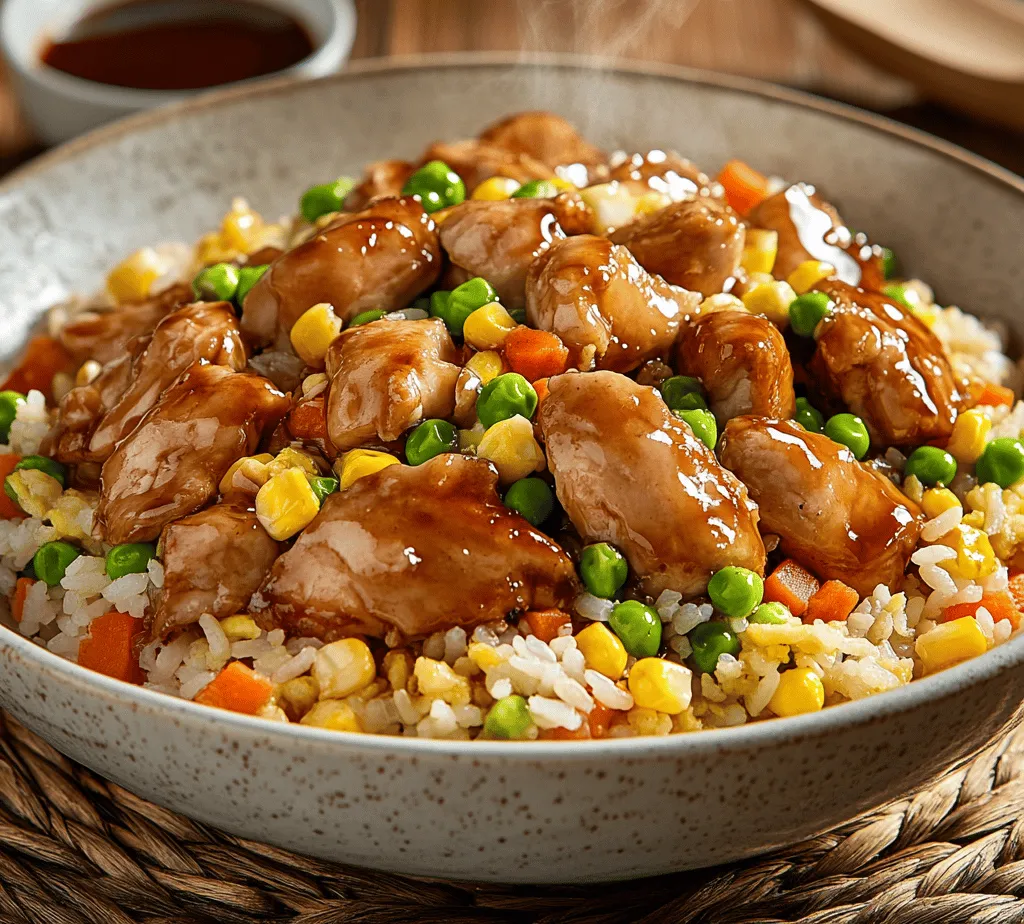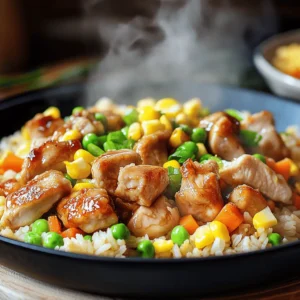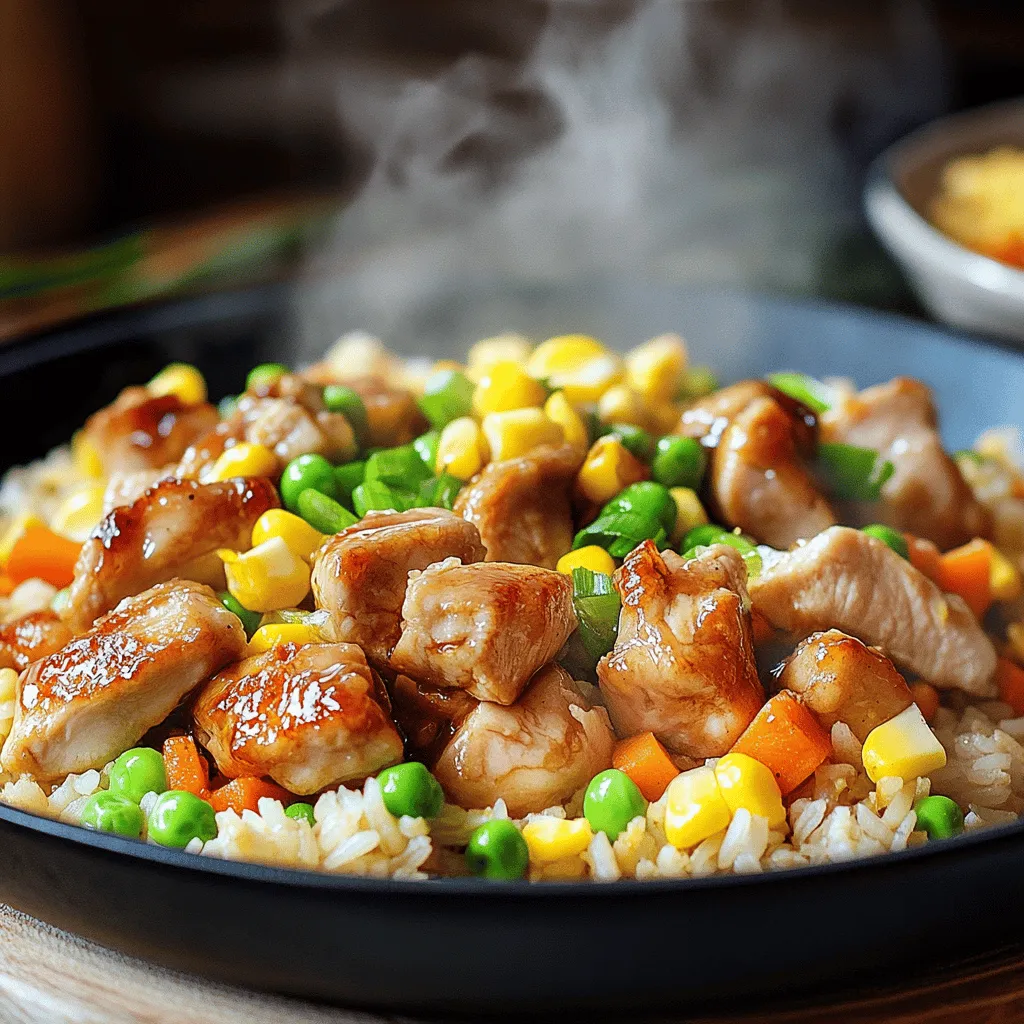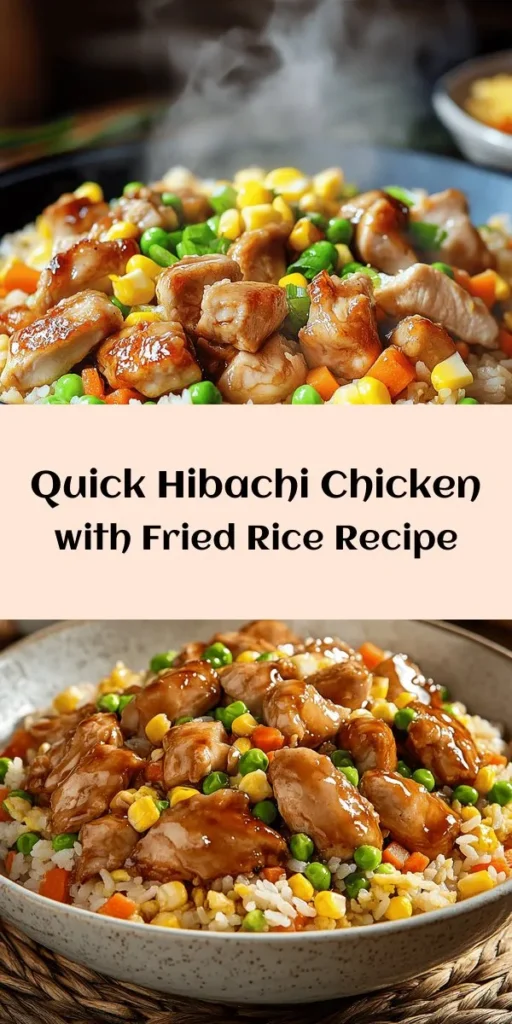Introduction
Hibachi cuisine has captured the hearts and taste buds of many food enthusiasts around the world. Originating from Japan, this style of cooking is not just about the food; it’s also about the experience. Hibachi cooking is characterized by its theatrical preparation and presentation, often seen in restaurants where chefs skillfully grill meats and vegetables before diners’ eyes. The sizzling sound and the aroma wafting through the air create an atmosphere that is both engaging and delicious, making hibachi a popular choice for family gatherings and celebrations.
However, while dining out can be a treat, there’s something incredibly rewarding about creating hibachi-style meals at home. Not only does it allow for a personalized touch in flavor and presentation, but it also offers health benefits and control over ingredients, making home-cooked hibachi meals a superb option. This article will guide you through preparing Hibachi Chicken with Fried Rice, a dish that stands out as a perfect weeknight meal. With its juicy chicken and flavorful fried rice, this recipe is sure to become a family favorite.
Understanding Hibachi Cooking
Hibachi, literally translating to “fire bowl,” refers to a traditional Japanese heating device used for cooking. In modern culinary terms, however, it often denotes a style of cooking wherein food is grilled on a flat iron griddle or an open flame. The cultural significance of hibachi in Japanese cuisine extends beyond just the food; it embodies a communal dining experience where family and friends gather to enjoy a meal together.
The techniques employed in hibachi cooking are not only about grilling but also about precision, timing, and the art of flavor layering. The food is cooked at high temperatures, which allows for the Maillard reaction—a chemical reaction that occurs when proteins are exposed to high heat—resulting in a beautifully seared exterior and a tender, juicy interior. This method of cooking enhances the natural flavors of the ingredients while also preserving their nutritional value.
One of the primary benefits of hibachi cooking is its ability to create a balanced meal. With a focus on fresh vegetables, lean proteins, and hearty grains, hibachi meals are not only satisfying but also nutritious. By incorporating a variety of colors and textures, you can create a dish that pleases the palate and is visually appealing.
Ingredients Overview
When preparing Hibachi Chicken with Fried Rice, the choice of ingredients plays a crucial role in achieving the authentic flavors associated with this cuisine. Below is a detailed description of each ingredient and its significance in the dish.
Boneless, Skinless Chicken Thighs
Using boneless, skinless chicken thighs instead of chicken breasts is a key decision in this recipe. Thighs are generally more flavorful and juicier than breasts, which can often dry out during cooking. The higher fat content in thighs contributes to a rich, succulent texture and allows the chicken to absorb the flavors of the marinade more effectively. This makes them ideal for hibachi cooking, where the goal is to enhance the natural flavors of the meat.
Jasmine Rice
Jasmine rice is a fragrant, long-grain rice that is often preferred in Asian cuisine, especially for fried rice dishes. One of the essential tips for making perfect fried rice is to use day-old rice. When rice is cooked and then refrigerated overnight, it dries out slightly, making it less sticky and preventing the grains from clumping together during frying. This results in a fluffy texture that is ideal for absorbing sauces and flavors.
Soy Sauce and Teriyaki Sauce
Both soy sauce and teriyaki sauce play pivotal roles in developing the dish’s flavor profile. Soy sauce adds a deep, umami-rich saltiness that enhances the overall taste of the chicken and rice. Teriyaki sauce, on the other hand, brings a sweet and savory element, thanks to its blend of soy sauce, sugar, and mirin. The combination of these sauces creates a complex flavor that is synonymous with hibachi cooking, providing a delicious glaze that coats the chicken and rice.
Oils Used
The choice of oil is essential in hibachi cooking, particularly for achieving the desired flavor and cooking temperature. Vegetable oil is often used for its high smoke point, making it suitable for high-heat cooking. However, adding sesame oil can elevate the dish with its distinct, nutty flavor. A blend of both oils can provide a balanced taste while ensuring that the ingredients cook evenly and develop a beautiful golden-brown crust.
Fresh Vegetables and Eggs
Fresh vegetables such as onions, bell peppers, and zucchini are staples in hibachi dishes. They not only add color and texture to the meal but also contribute vital nutrients and fiber. Additionally, incorporating eggs into the fried rice is a traditional hibachi practice. Scrambled eggs add richness and protein, rounding out the dish and enhancing its overall nutritional profile.
Optional Ingredients
While the main components of Hibachi Chicken with Fried Rice are crucial, optional ingredients, such as a hibachi-style dipping sauce, can elevate the meal further. This sauce, often made from soy sauce, mirin, and a hint of ginger, serves as a delightful accompaniment that enhances the flavors of the grilled chicken and fried rice. It can also be served alongside other hibachi dishes, making it a versatile addition to your culinary repertoire.
Step-by-Step Instructions
Now that we have a solid understanding of the ingredients and their importance, let’s dive into the step-by-step instructions for preparing Hibachi Chicken with Fried Rice.
Marinating the Chicken
The first crucial step in crafting flavorful hibachi chicken is marination. Marinating not only infuses the chicken with flavor but also helps tenderize the meat, resulting in a juicy final product.
1. Prepare the Marinade: In a mixing bowl, combine soy sauce, teriyaki sauce, minced garlic, and ginger. The balance of these ingredients will create a fragrant marinade that seeps into the chicken.
2. Marinate the Chicken: Place the boneless, skinless chicken thighs into the marinade, ensuring they are well-coated. For optimal flavor infusion, allow the chicken to marinate for at least 30 minutes. If time permits, marinating for up to 2 hours in the refrigerator can significantly enhance the flavor.
3. Tips for Enhancing Flavor: To elevate the marinade, consider adding a splash of rice vinegar or a sprinkle of sesame oil for added depth. Additionally, if you prefer a bit of heat, incorporating a dash of sriracha or red pepper flakes can provide a satisfying kick.
Cooking the Chicken
Once the chicken has marinated, it’s time to cook it to perfection.
1. Preheat the Griddle or Skillet: To achieve that signature hibachi sear, preheat your griddle or a large skillet over medium-high heat. Ensure it’s hot before adding any oil.
2. Add the Oil: Drizzle a small amount of vegetable oil into the preheated skillet. Swirl the oil around to coat the surface evenly. This will help prevent sticking and promote even cooking.
3. Cook the Chicken: Carefully place the marinated chicken thighs onto the skillet, ensuring they are not overcrowded. The goal is to allow the chicken to sear beautifully. Cook for about 5-7 minutes on each side or until the internal temperature reaches 165°F (75°C).
4. Techniques for Achieving the Perfect Golden-Brown Chicken: Avoid flipping the chicken too frequently; instead, let it cook undisturbed to create a golden crust. Use tongs to flip the thighs only once. If you find the chicken is browning too quickly, lower the heat slightly to prevent burning.
5. Safety Tips for Handling Raw Chicken: Always practice food safety when handling raw chicken. Use separate cutting boards and utensils for raw and cooked chicken to avoid cross-contamination. Ensure that any surfaces that come into contact with raw chicken are thoroughly cleaned afterward.
By following these steps, you’ll have beautifully grilled hibachi chicken that’s bursting with flavor. The next part of this recipe will delve into preparing the fried rice and any finishing touches that will elevate your hibachi experience to a restaurant-quality level. Stay tuned for the continuation of this delectable journey into the world of homemade hibachi cooking!

Scrambling the Eggs
One of the hallmark characteristics of hibachi-style fried rice is the perfectly scrambled eggs that add richness and flavor to the dish. To achieve this, begin by cracking 2-3 large eggs into a bowl and whisking them thoroughly until the yolks and whites are fully combined. This ensures a uniform texture when the eggs are cooked.
Heat a non-stick skillet or wok over medium-high heat and add a splash of oil. Once the oil is hot, pour in the whisked eggs. Allow them to sit undisturbed for a few seconds until the edges start to set. Use a spatula to gently push the eggs from the edges toward the center, creating soft curds. Continue this process until the eggs are just set but still slightly creamy.
Tips for Perfectly Scrambled Eggs in a Stir-Fry Context
Achieving the perfect scrambled eggs for your hibachi fried rice requires attention to detail. Here are a few tips:
1. Use Fresh Eggs: Fresh eggs yield a better texture and flavor. They are less watery, which helps achieve that fluffy consistency.
2. Control the Heat: Cooking eggs on too high heat can lead to overcooking and a rubbery texture. A medium-high setting is ideal for quick cooking while retaining creaminess.
3. Season Wisely: Adding a pinch of salt and pepper to the eggs before scrambling can enhance their natural flavor without overpowering the dish.
4. Remove Promptly: The eggs should be removed from the skillet as soon as they are cooked through. They will continue to cook from residual heat, so it’s best to err on the side of caution here.
Sautéing the Vegetables
Next, it’s time to sauté the vegetables, a crucial step that adds flavor and texture to your hibachi chicken with fried rice. A classic mix includes onions, bell peppers, and peas, but feel free to incorporate other favorites like carrots, broccoli, or mushrooms.
How to Choose and Prepare Vegetables for Optimal Flavor
When selecting vegetables for your fried rice, consider freshness and color. Vibrant vegetables not only look appealing but also contribute varying textures and flavors.
– Onions: Yellow or white onions add sweetness; green onions can be used for garnish.
– Bell Peppers: Red, yellow, or green peppers provide a sweet crunch and a pop of color.
– Peas: Fresh or frozen peas are sweet and pair well with the other ingredients.
Before cooking, wash and chop your vegetables into uniform pieces to ensure even cooking.
The Significance of Cooking Order in Stir-Frying
In stir-frying, the order of adding ingredients can significantly impact the final dish. Start with the aromatics, such as garlic and onions, as they take longer to cook. Sauté these until fragrant, then add your other vegetables, beginning with the ones that require more time to soften, like carrots. Follow with quicker-cooking vegetables, such as bell peppers and peas. This method ensures that everything is cooked to perfection without any ingredient becoming mushy.
Preparing the Fried Rice
Now comes the star of the dish: the fried rice. You can use either fresh or day-old rice, but day-old rice is often preferred for its firmer texture, which helps prevent clumping.
Techniques for Breaking Up Clumps in Day-Old Rice
If you’re using day-old rice, begin by breaking up any clumps. Transfer the rice to a bowl and use a fork to gently fluff it, separating the grains. This step is crucial for achieving that restaurant-style fried rice texture.
Flavor Layering with Soy and Teriyaki Sauces
Once your rice is prepped, it’s time to add flavor. Pour in 2-3 tablespoons of soy sauce and 1 tablespoon of teriyaki sauce. These sauces not only enhance the taste but also add a beautiful color to the rice. Stir well to ensure the sauces are evenly distributed throughout the rice.
Achieving the Right Texture: Crispy vs. Soft Rice
The texture of your fried rice can vary based on personal preference. For crispy rice, allow it to cook undisturbed for a couple of minutes before stirring—this creates a slight crust. If you prefer a softer texture, keep stirring more frequently to prevent any browning.
Combining the Ingredients
After your rice is cooked to your liking, it’s time to bring all the components together. Return the scrambled eggs to the skillet, followed by the sautéed vegetables and hibachi chicken.
Best Practices for Mixing Everything Without Overcooking
To combine everything effectively, use a spatula to fold the ingredients gently. This technique helps keep the rice grains intact while evenly distributing the chicken, vegetables, and eggs. Avoid overcooking at this stage; just heat everything through until it’s hot and well mixed.
Importance of Adjusting Seasoning Before Serving
Before serving, take a moment to taste the fried rice. This is your opportunity to adjust the seasoning. If it needs a bit more umami, add another splash of soy sauce or a dash of salt. Remember, it’s easier to add more seasoning than to fix an overly salty dish.
Serving Suggestions
Presentation can elevate your hibachi chicken with fried rice from ordinary to extraordinary. Here are some serving ideas:
1. Plating: Use a large serving platter to display the rice and chicken. Create a mound of fried rice in the center and arrange the chicken around it for an inviting look.
2. Garnish: Fresh herbs like cilantro or additional green onions can add a pop of color and freshness. A sprinkle of sesame seeds can also enhance visual appeal.
3. Suggested Pairings: Complement your hibachi meal with drinks like iced green tea or a light beer. For side dishes, consider miso soup or a simple cucumber salad to balance the meal.
4. Communal Style: One of the joys of hibachi-style meals is sharing them with family and friends. Serve everything family-style, allowing guests to help themselves and create personalized portions.
Nutritional Analysis
Understanding the nutritional value of your hibachi chicken with fried rice can help make informed choices about this delicious dish.
Breakdown of Calories and Macronutrients Per Serving
A standard serving of hibachi chicken with fried rice contains approximately:
– Calories: 600-700 kcal
– Protein: 30-35 grams
– Carbohydrates: 70-80 grams
– Fat: 20-25 grams
Keep in mind that these values can vary based on portion sizes and ingredients used.
Health Benefits of Key Ingredients
– Chicken: A lean protein source that contributes to muscle health and satiety.
– Vegetables: Rich in vitamins, minerals, and fiber, they enhance the nutritional profile of the dish.
– Rice: Provides energy through carbohydrates, with whole grain options offering additional fiber.
Tips for Making the Dish Healthier, if Desired
To lower the calorie count or sodium content, consider these adjustments:
– Use Less Soy Sauce: Opt for low-sodium soy sauce to reduce sodium intake.
– Add More Vegetables: Boost fiber and nutrients by increasing the vegetable portion.
– Substitute with Cauliflower Rice: For a lower-carb option, replace traditional rice with cauliflower rice.
Conclusion
Making hibachi chicken with fried rice at home is not just about enjoying a delicious meal; it’s also about the experience of cooking and sharing it with loved ones. The combination of tender chicken, vibrant vegetables, and flavorful rice offers a delightful balance that can be tailored to fit any palate.
Feel free to experiment with different ingredients, sauces, and cooking techniques, as this dish is incredibly versatile. Whether you stick to the classic recipe or add your personal flair, the satisfaction of creating a hibachi-style meal in your own kitchen is unmatched. Embrace the opportunity to explore variations and enjoy the delightful flavors of homemade hibachi!



